A gigantic U.S. Air Force RQ-4 is currently flying over Ukraine, broadcasting its position for everyone to see.
U.S. RQ-4 Global Hawk UASs (Unmanned Aerial Systems) belonging to the 9th Operations Group/Detachment 4th of the U.S. Air Force deployed to Sigonella from Beale Air Force Base, California, have been flying ISR (Intelligence Surveillance Reconnaissance) missions in support of EUCOM, AFRICOM and CENTCOM theater mission tasking since 2011.
Beginning in 2015, they have started flying over Ukraine as well and, as already reported, instead of keeping a low-profile, they can be regularly tracked not only by “standard” ground radars, but even by commercial ADS-B receivers like those feeding online flight tracking systems such as Flightradar24.com, PlaneFinder.net or Global ADS Exchange while its imagery intelligence (IMINT) sensors take a look at Russian bases in Crimea and gather information about the pro-Russia forces on the ground in the Dombass region of Ukraine.
As we write this story, 19:00 GMT on Jul. 20, a Global Hawk drone can be tracked as it performs an ISR mission over Ukraine at 53,000 feet.
The unmanned aircraft has been airborne for some 17 hours. It started tracking early in the morning after departing from Sigonella, then it has headed east, flown over Bulgaria to the Black Sea, “skirted” Crimea, performed some racetracks off Sochi and then headed back to make a tour of Ukraine.
Here are some screenshots taken by our friend and famous ADS-B / ModeS tracking enthusiast running the popular @CivMilAir @ADSBTweetBot Twitter feeds:
Heading west over #Ukraine at 53,000ft
?? USAF RQ4 Global Hawk #UAV #drone pic.twitter.com/ceH1JSLWPw
— CivMilAir ✈ ? (@CivMilAir) July 20, 2017
As reported several times here, it’s difficult to say whether the drone can be tracked online by accident or not. But considered that the risk of breaking OPSEC with an inaccurate use of ADS-B transponders is very well-known, it seems quite reasonable to believe that the unmanned aircraft purposely broadcasts its position for everyone to see, to let everyone know it is over there. Since “standard” air defense radars would be able to see them regardless to whether they have the transponder on or off, increasingly, RC-135s and other strategic ISR platforms, including the Global Hawks, operate over highly sensitive regions, such as Ukraine or the Korean Peninsula, with the ADS-B and Mode-S turned on, so that even commercial off the shelf receivers (or public tracking websites) can monitor them.
Russian spyplanes can be regularly tracked as well: the Tu-214R, Russia’s most advanced intelligence gathering aircraft deployed to Syria and flew along the border with Ukraine with its transponder turned on.
Top image: Flightradar24 screenshot via @CivMilAir who deserves the usual H/T.









